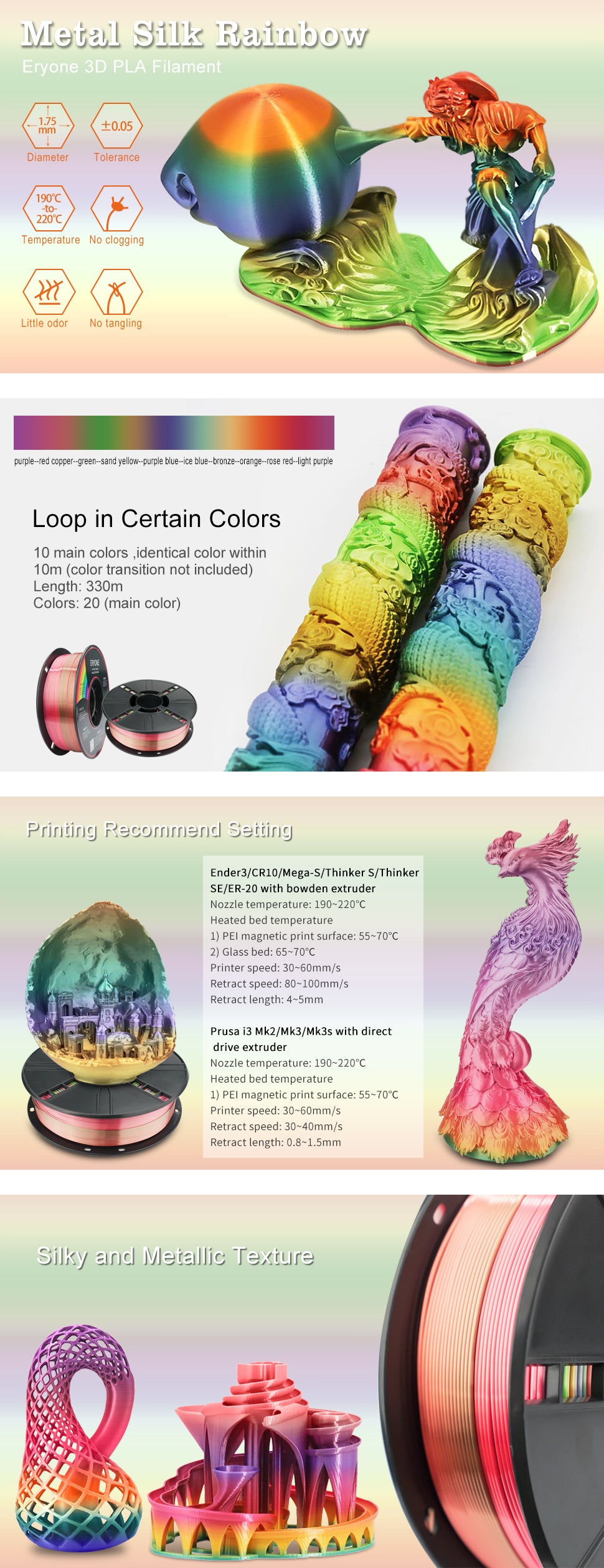ERYONE SPECIAL PLA Filament,including Rainbow PLA/Marble PLA/Wood PLA/LUMINOUS PLA
Get what you want with budle price!





Feature:
Metallic silk rainbow PLA has an unique silk metallic texture. A 10-meter filament is in one color: Purple - copper - green - sand yellow - purple blue - ice blue - bronze - orange - rose - pale purple.
10 colors in a cycle, bright colors, clear gradient colors, fixed sort order; 1KG filament is about 330 meters long, in 20 colors, and has high brightness and strong silk rainbow metal texture.
Specifications:
- Filament Diameter: 1.75mm
- Tolerance: ±0.05mm
- Specification: Net weight 1 kg, 330m in length, in 20 color
- Printing Temperature: 190°C-220°C
- Heated Bed Temperature: 30-100mm/s
- Printing Speed: 55-70℃
FAQ
1.Q:The printed model has a single color, why?
A:The length of the rainbow PLA in each color is constant, and the customer calculates the length or weight of filaments needed to print the model according to how many colors customers want to show when slicing.
2.Q: The color of an actual printed object is different from that of filament itself, why?
A: It’s a normal phenomenon. Restricted by process and objective chemical changes, some colors of rainbow filaments have a coating effect; that is, the outer surface is in one color, and the inner is in another color.
3.Q: Why my filament tangles? How can I solve it?
A: The tangle of filament isn’t caused by the disordered or the imperfect winding. According to the production technology of filament, the filament winds back and forth (from left to right and then from right to left). Normally, there is no overline tangle. A common cause of tangle is that the filament end is not fixed to the holes of spool. Overline tangle or the changed winding direction make filament tangle. So customers need to fix the filament end to the proper holes of the spool.
4.Q: Can PLA be used to print tableware?
A: Not recommended. Although PLA is degradable, food-grade raw material, the PLA with toner is non-food grade.
5.Q: The nozzle is clogged by PLA, and how can I solve it?
A: Inconstant filament diameter, the lower nozzle temperature and frequent replacement with different kinds of filaments will lead to this problem. So, before you get started, clean the nozzle and turn up the temperature to a proper value.
6.Q: My prints have web-like strings (stringing) issues. How can I troubleshoot it?
A: Too high temperature makes the PLA filament melt and flow so fast. Please turn the temperature down to a proper value.
The retracting parameters are improper, so adjust the retracting length and speed.
7.Q: There are too much melted filament around the nozzle. What should I do?
A: This problem can be attributed to over-high temperature, low printing speed, and in the slice software, the nozzle diameter doesn’t match with the extrusion output.
8.Q: The PLA filament was perfect when I opened the package. After several times of intermittent printing, my PLA filament snaps by accident during printing. Why?
A: Normally, the PLA filament in the printing process will not snap by themselves. However, after being affected by moisture, the degradable material PLA will be more brittle and easier to break, so you should pay attention to dampproof.
9.Q: The surface of my print isn’t very smooth, and the extruded filament has inconstant diameters. Why?
A: The printing temperature is too high or too low. The temperature doesn’t match well with the printing speed. You need to adjust the printing speed or temperature.
10.Q: Why my PLA-printed objects don't stick to the heated bed? How do I solve?
A: The distance between the nozzle and the bed is too far. Make sure your heated bed is leveled and it’s clean. Then judge if the printing temperature and heated bed temperature are too low, and our customers should adjust them to correct ranges.










